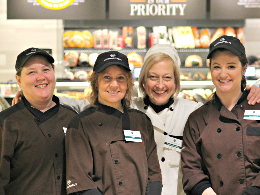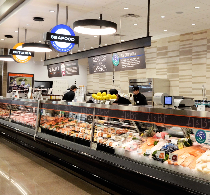L&B Guide to Cheeses
November 24, 2022
If you’re like us, the holiday season is a mad rush of happy hours, neighbors dropping in for cocktails and kids coming home to spend long weekends with the family. ‘Tis the season for cheeseboards! They make for such easy holiday entertaining: there’s nothing to cook, bake or whirl up in the blender. Just unwrap a few cheeses — and maybe some crackers, fruit and nuts — and all the different shapes and flavors will create a board that’s as fun to look at as it is wonderful to eat.
Of course, for all that simplicity, it can be tricky to choose the cheeses. You want the kind of variety that will appeal to both the most adventurous and the most picky of your guests. You want to mix up the textures: hard, soft and creamy. And you want the cheese to complement whatever drinks you’ll be serving.
With that in mind, our cheesemongers have put together this helpful guide to the main cheese categories, including the different cheeses that fall under them — and some terrific wine, spirit and nonalcoholic beverage pairing suggestions. If you want more information about specific cheeses or pairings, come in and see us, we love talking cheese!

Fresh Cheeses (chèvre, mascarpone, mozzarella and ricotta)
If you’re looking for a mild cheese, fresh cheeses are your jam. Fresh cheeses are unripened (or aged), which means they can be made in a day or two and eaten right away.
In general, they have a milky, clean flavor — and they can sometimes be lightly floral. Of course, the flavor will also depend on the kind of milk used to make the cheese. For example, chèvre is a goat cheese, and it has more bright, tangy citrus notes, while sheep’s milk cheeses, like feta, have an undercurrent of sweetness.
Pairing suggestions: black tea, kombucha, elderflower cordial, hard cider and gin and tonic.
Bloomy-Rind Cheeses (Brie and Camembert)
Bloomy-rind cheeses (sometimes called soft-ripened) are known for their velvety white rinds, funky wrinkles and high butterfat content. You’ll find them labeled single-, double- or triple-crème. Both double- and triple-crème cheeses have extra cream added — for example, a triple-crème cheese is 75% butterfat or more. Talk about decadent, rich and irresistible!
You can bring this cheese to any party, and it’s always the first to disappear. It has a lovely mild flavor and an ultra creamy texture that everyone loves. The rinds are meant to be eaten, and they have a wonderfully delicate mushroom flavor, but of course, you can also slice them off.
Pairing suggestions: coffee, sparkling water, Champagne and dry hard cider.
Washed-Rind Cheeses (Thunder, Gruyère and Taleggio)
Washed-rind cheeses come with a moist or sticky exterior and some variety of orange-pink rind — created by bathing them in cider, brine, wine or beer. They also come with a pungent, funky, earthy aroma, but we’re here to tell you: don’t let that turn you off.
Many washed-rind cheeses, even the stinkiest, have an easy, savory flavor — think nutty, bready or yeasty — and a delightfully oozy-soft texture. If you’re looking for something a little more unique, a washed-rind cheese will never disappoint.
Pairing suggestions: cherry apéritif, apple brandy, Champagne and Belgian ales.
Semi-Soft Cheeses (Havarti, fontina and Port Salut)
Semi-soft cheeses are some of our most popular — they’re super approachable crowd pleasers. They’re minimally aged, so they have a higher moisture content, between 36 and 45%.
People love semi-soft cheeses for their mild flavor and meltability, which makes them great in hot casseroles and sandwiches. They’re also right at home on a cheeseboard, where they provide an easy yet interesting option for folks who are just getting into cheese.
Pairing suggestions: Riesling, sauvignon blanc, chardonnay, pilsner and Old Fashioned.
Blue Cheeses (Gorgonzola, Stilton and Roquefort)
Blue cheeses are injected with different kinds of penicillium, and that’s what gives them the blue or green mold veins that are so eye-catching … and so polarizing. People seem to either love or hate blue cheese, but no cheeseboard would really be complete without the pungent classic. It’s always a good conversation starter.
In terms of flavor, blue cheeses can range from mild (Gorgonzola) to strong (Roquefort). We often describe them as fudgy, piquant and salty, and we like to serve them with a side of honey or caramelized nuts for balance. Even better: dark chocolate. (Total game-changer — you’ll thank us!)
Pairing suggestions: port, merlot, Riesling, chocolate stout and liquid chocolate.
Semi-Hard Cheeses (Cheddar, Gouda, and Manchego)
Semi-hard cheese (sometimes called semi-firm) is one of the broadest categories, so it’s harder to generalize about them, but we can say that they tend to have less moisture than the softer cheeses. They’re also aged, so they have richer flavor notes, ranging from warm butterscotch, caramel and toasted nuts to tangy, delightfully bitter and salty.
Some of our most popular cheeses, like cheddar, fall in the semi-hard cheese category. But even a cheese you know and love can be a fun addition to your cheeseboard if you mix it up a little. Instead of a mild orange cheddar, try an aged white cheddar — it’ll have a nice, tangy bite and a creamy yet crumbly and slightly crunchy texture.
Pairing suggestions: coffee, hop tea, pinot noir, Chardonnay and sake.
Hard Cheeses (Parmigiano-Reggiano and Romano)
Hard cheeses (sometimes called firm) are aged for months or even years, so they’re the driest of the cheeses and they’re chock-full of concentrated flavor — savory and full of brown butter and nuts. They tend to have a granular, almost crumbly texture that lends itself better to grating than slicing.
That said, don’t underestimate the complexity that a hard cheese can add to a cheeseboard, especially if you’ve included a little charcuterie — its rich flavor is a perfect complement to fatty meats. A little goes a long way when serving a hard cheese, however, so think about shavings rather than chunks.
Pairing suggestions: Chianti, sherry, sweet hard ciders, India pale ale and Belgian dark ale.










